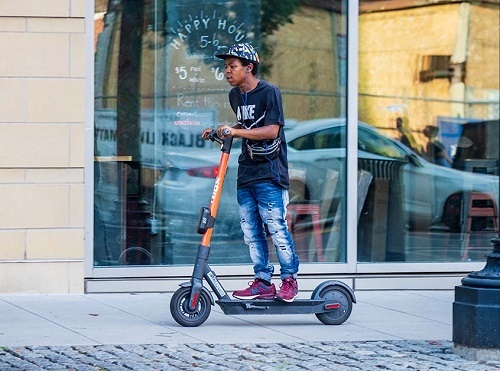Many cities are turning to speed limiters for electric scooters to address concerns about rider safety and conflicts with pedestrians, according to new study conducted by the Insurance Institute for Highway Safety. Yet mandating low travel speeds may push more-scoot use onto sidewalks, the group’s research suggested.
[Above photo via IIHS]
“Our results show that restricting scooters to low speeds offers a trade-off,” said Jessica Cicchino, IIHS vice president of research and the study’s lead author, in a statement.
“At slow speeds, riders are more likely to choose the sidewalk over the road,” she added. “That puts them in less danger from cars but could mean more conflicts with people on foot.”
IIHS noted that e-scooter use has blossomed in the United States since the first shared e-scoot program officially launched in 2017. But as ridership has increased, so have injuries and citizen complaints. In response, many towns and cities have required speed limiters for shared e-scooters, with a 15 mph maximum speed the common limit.
To help understand the effect of different maximum speeds, IIHS researchers compared rider behavior in Austin, TX, and Washington, D.C. Austin caps shared e-scooter speeds at 20 mph, while Washington, D.C., makes the maximum speed 10 mph — one of the lowest in the United States. Neither city has an effective way to require speed limiters on privately owned scooters, IIHS noted in its study.
In both cities, e-scooter riders overwhelmingly rode in bike lanes where they were available. Where there were no bike lanes, however, riders in Washington, D.C., were 44 percent more likely than Austin riders to choose to ride on the sidewalk – and were more likely to favor the sidewalk despite lower vehicle traffic volumes when compared to the 16 Austin observation sites.
Overall, however, riders tended to choose the sidewalk when motor vehicle traffic was heavier, as well as on arterials and two-way roads. In contrast, the researchers recorded an increase in e-scooter riders in vehicle travel lanes on weekends, possibly because of lighter traffic.
E-scooter riders are doubtless safer from fatal injuries when they’re not sharing the road with motor vehicles. However, the net impact of sidewalk riding on less serious injuries to e-scooter users and pedestrians is unclear. A previous IIHS study showed that most e-scooter rider injuries in Washington, D.C., happened on the sidewalk but also that injuries that occurred on the road were more severe.
“E-scooter users clearly take risk into account when choosing where to ride,” said IIHS’s Cicchino. “Many are also conscious of the risk of hitting a pedestrian. [But] slowing down the fastest sidewalk riders should help prevent crashes and reduce the severity of injuries when e-scooters hit pedestrians. The clear preference for bike lanes also gives communities another reason to focus on expanding their bicycle networks.”
The researchers also analyzed rider behavior in the central business district of Washington, D.C., where sidewalk riding is prohibited. Despite the ban, IIHS found that two-thirds of e-scooter users rode on the sidewalks at locations without bike lanes that area – noting that riders in the central business district without bike lanes were also 38 percent more likely than riders in Austin to choose the sidewalk over the street.
There’s little evidence sidewalk bans are any more effective elsewhere. Nevertheless, two-thirds of U.S. communities are considering them or have them in place already, according to a 2022 survey by the Behavioral Traffic Safety Cooperative Research Program.
Others are mulling banning e-scooters from all or certain roads. Improvements in e-scooter technology could offer an alternative solution, IIHS noted, with some e-scooter companies now deploying systems that can detect when their e-scooters are on sidewalks.
As this technology matures, it could be used to apply separate speed restrictions for sidewalk riders or prevent sidewalk riding altogether in key locations, IIHS noted.


